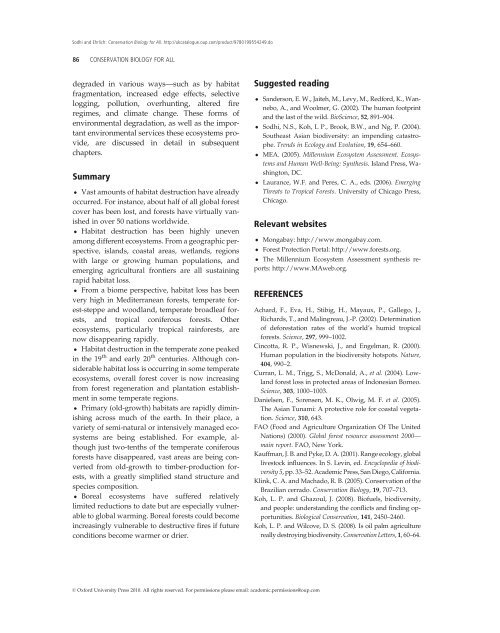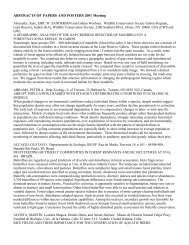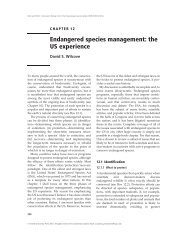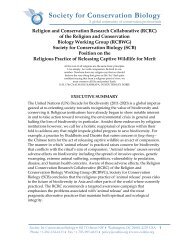Habitat Destruction: Death by a Thousand Cuts - Society for ...
Habitat Destruction: Death by a Thousand Cuts - Society for ...
Habitat Destruction: Death by a Thousand Cuts - Society for ...
- No tags were found...
You also want an ePaper? Increase the reach of your titles
YUMPU automatically turns print PDFs into web optimized ePapers that Google loves.
Sodhi and Ehrlich: Conservation Biology <strong>for</strong> All. http://ukcatalogue.oup.com/product/9780199554249.do<br />
86 CONSERVATION BIOLOGY FOR ALL<br />
degraded in various ways—such as <strong>by</strong> habitat<br />
fragmentation, increased edge effects, selective<br />
logging, pollution, overhunting, altered fire<br />
regimes, and climate change. These <strong>for</strong>ms of<br />
environmental degradation, as well as the important<br />
environmental services these ecosystems provide,<br />
are discussed in detail in subsequent<br />
chapters.<br />
Summary<br />
· Vast amounts of habitat destruction have already<br />
occurred. For instance, about half of all global <strong>for</strong>est<br />
cover has been lost, and <strong>for</strong>ests have virtually vanished<br />
in over 50 nations worldwide.<br />
· <strong>Habitat</strong> destruction has been highly uneven<br />
among different ecosystems. From a geographic perspective,<br />
islands, coastal areas, wetlands, regions<br />
with large or growing human populations, and<br />
emerging agricultural frontiers are all sustaining<br />
·<br />
rapid habitat loss.<br />
From a biome perspective, habitat loss has been<br />
very high in Mediterranean <strong>for</strong>ests, temperate <strong>for</strong>est-steppe<br />
and woodland, temperate broadleaf <strong>for</strong>ests,<br />
and tropical coniferous <strong>for</strong>ests. Other<br />
ecosystems, particularly tropical rain<strong>for</strong>ests, are<br />
·<br />
now disappearing rapidly.<br />
<strong>Habitat</strong> destruction in the temperate zone peaked<br />
in the 19 th and early 20 th centuries. Although considerable<br />
habitat loss is occurring in some temperate<br />
ecosystems, overall <strong>for</strong>est cover is now increasing<br />
from <strong>for</strong>est regeneration and plantation establishment<br />
·<br />
in some temperate regions.<br />
Primary (old-growth) habitats are rapidly diminishing<br />
across much of the earth. In their place, a<br />
variety of semi-natural or intensively managed ecosystems<br />
are being established. For example, although<br />
just two-tenths of the temperate coniferous<br />
<strong>for</strong>ests have disappeared, vast areas are being converted<br />
from old-growth to timber-production <strong>for</strong>ests,<br />
with a greatly simplified stand structure and<br />
·<br />
species composition.<br />
Boreal ecosystems have suffered relatively<br />
limited reductions to date but are especially vulnerable<br />
to global warming. Boreal <strong>for</strong>ests could become<br />
increasingly vulnerable to destructive fires if future<br />
conditions become warmer or drier.<br />
Suggested reading<br />
· Sanderson,<br />
· Sodhi,<br />
· MEA.<br />
· Laurance,<br />
E. W., Jaiteh, M., Levy, M., Red<strong>for</strong>d, K., Wannebo,<br />
A., and Woolmer, G. (2002). The human footprint<br />
and the last of the wild. BioScience, 52,891–904.<br />
N.S., Koh, L P., Brook, B.W., and Ng, P. (2004).<br />
Southeast Asian biodiversity: an impending catastrophe.<br />
Trends in Ecology and Evolution, 19, 654–660.<br />
(2005). Millennium Ecosystem Assessment. Ecosystems<br />
and Human Well-Being: Synthesis. Island Press, Washington,<br />
DC.<br />
W.F. and Peres, C. A., eds. (2006). Emerging<br />
Threats to Tropical Forests. University of Chicago Press,<br />
Chicago.<br />
Relevant websites<br />
Mongabay: http://www.mongabay.com.<br />
·<br />
Forest Protection Portal: http://www.<strong>for</strong>ests.org.<br />
The Millennium Ecosystem Assessment synthesis reports:<br />
http://www.MAweb.org.<br />
REFERENCES<br />
Achard, F., Eva, H., Stibig, H., Mayaux, P., Gallego, J.,<br />
Richards, T., and Malingreau, J.-P. (2002). Determination<br />
of de<strong>for</strong>estation rates of the world’s humid tropical<br />
<strong>for</strong>ests. Science, 297, 999–1002.<br />
Cincotta, R. P., Wisnewski, J., and Engelman, R. (2000).<br />
Human population in the biodiversity hotspots. Nature,<br />
404, 990–2.<br />
Curran, L. M., Trigg, S., McDonald, A., et al. (2004). Lowland<br />
<strong>for</strong>est loss in protected areas of Indonesian Borneo.<br />
Science, 303, 1000–1003.<br />
Danielsen, F., Srensen, M. K., Olwig, M. F. et al. (2005).<br />
The Asian Tunami: A protective role <strong>for</strong> coastal vegetation.<br />
Science, 310, 643.<br />
FAO (Food and Agriculture Organization Of The United<br />
Nations) (2000). Global <strong>for</strong>est resource assessment 2000—<br />
main report. FAO, New York.<br />
Kauffman, J. B. and Pyke, D. A. (2001). Range ecology, global<br />
livestock influences. In S. Levin, ed. Encyclopedia of biodiversity<br />
5, pp. 33–52. Academic Press, San Diego, Cali<strong>for</strong>nia.<br />
Klink, C. A. and Machado, R. B. (2005). Conservation of the<br />
Brazilian cerrado. Conservation Biology, 19, 707–713.<br />
Koh, L. P. and Ghazoul, J. (2008). Biofuels, biodiversity,<br />
and people: understanding the conflicts and finding opportunities.<br />
Biological Conservation, 141, 2450–2460.<br />
Koh, L. P. and Wilcove, D. S. (2008). Is oil palm agriculture<br />
really destroying biodiversity. Conservation Letters, 1,60–64.<br />
© Ox<strong>for</strong>d University Press 2010. All rights reserved. For permissions please email: academic.permissions@oup.com






